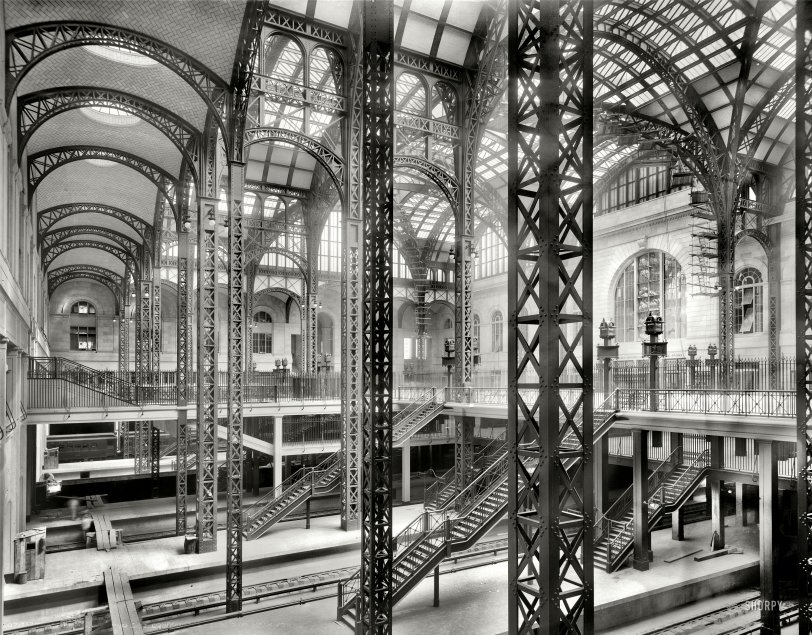


Framed or unframed, desk size to sofa size, printed by us in Arizona and Alabama since 2007. Explore now.
Shorpy is funded by you. Patreon contributors get an ad-free experience.
Learn more.

- Lofty addition
- In 1912
- Keenan Building
- Six years old
- Taken from the P.J. McArdle Roadway?
- It stood only 47 years
- Three track mind
- Incline to the right
- Reach for the sky, 1912 style
- No clean sweep
- Same Job Title, Same Face
- Sadly Lost
- Beautiful ...
- Where you get your kicks
- Aim High
- Pueblo Revival sisters
- Pueblo Neoclassicism
- Milk Man
- Regional dialect.
- Spielberg's inspiration
- Great Photo
- Loaf Story
- Do you still have the Rakes category?
- Could almost be a scene from the 1957 movie 'Hell Drivers'
- The Wages of Fear.
- Conspicuous by their absence
- Got Milk?
- All that aluminum
- No lefties
- Smoke 'em if you've got 'em
Print Emporium
Pennsylvania Station: 1910

New York circa 1910. "Track level, main and exits, concourses, Pennsylvania Station." 8x10 dry plate glass negative, Detroit Publishing Co. View full size.
Like a rat
Perpsters comment reminds me of the saying from architecture historian Vincent Scully: "Through it one entered the city like a god, one scuttles in now like a rat."
The current Penn Station is New York's greatest embarrassment.
Longevity
Looks like a train of Long Island Rail Road MP54 cars over on Track 14 at the bottom left. Some of these cars outlasted the station, not being withdrawn from service until the early 1970s.
Not ADA Compliant?
How did disabled persons take the train back then? Pretty much like they would now -- a redcap would have taken them down in an elevator.
The ADA is a wonderful law that has done a great deal of good, but it can't change reality. I remember once the Amtrak ADA-compliance officer inspected my station and said we would need to install "tactile bumps" along the 6 concrete platforms bordering the tracks. I asked why, and she said to facilitate access by blind persons using a cane. I responded that I would never allow a blind person to go out into the yard unaccompanied, that it was incredibly dangerous even for those with perfect vision, since there were constantly trains moving through. She said, yes, but they have that right under the law.
Horrible
I don't know if he's still around but there used to be someone who posted when a picture of Pennsylvania station came up, saying how the photo didn't reflect how horrible the place really was and how it was a good thing that the tore it down. Just so you know that not everyone shares our enthusiasm for the structure.
A Structural Fantasy
The marvelous steel arches and glass vaults of Penn Station's concourse are just as decorative and "artificial" as the Guastavino tile vaults and colossal Corinthian columns in in the Main Waiting Room (the part of the station that was modeled on the Baths of Caracalla) next door. As Hilary Ballon showed in her book "New York's Pennsylvania Stations," the actual structure of the concourse is formed by three hidden sets of steel trusses forming X-patterns in plan above this space. All the apparent structure you see here is actually hung from these supports. The result may be an attempt to answer the question: What would the Romans have have done with steel and glass? It is all a splendid illusion, but in the immortal words of Jerry Seinfeld, "not that there's anything wrong with it."
Artful and skillful
Back then it seems that there wasn't much of today's division between the haughty artist (architect) coming up with gaga designs and the lowly craftsman (civil engineer) who has to put them into being.
They were much in love with their (then relatively new) materials and used them to great effect. And somewhow architects and engineers seem to have been on the same planet, not to mention the same wavelength. Maybe both were artisans, rather than artist and craftsman, respectively.
Today's architecture rarely is up to that. From purely utilitarian, through trite and tacky to ugly to downright stupid *, most of the time. My 5 Cents, anyway.
* Stupid would be, for instance, when function follows form, like using huge glass fronts in rather sunny places, or flat roofs with 60 inches of annual rain.
Magnificent structure
Thanks for posting this wonderful shot.
Herringbone
Is the arched ceiling surface made from masonry units or tile?
Imagine the hours involved on just that part of the job.
Stairs Remain
Some of those stairs to the platform still remain, but at the track level, the light and airy station has been reduced to a dark, dingy basement.
Stairways to heaven
It makes me queasy to even think about climbing up and around on that makeshift scaffolding. No handrails. No looking down. No way.
Scary Scaffolding!
Who wants to climb up that scaffolding in the upper right corner?
Not ADA Compliant
How did disabled persons take the train back th-? Oh.
Gilbert's finest
Anyone else look at this and think, "Erector set"?
Glorious
A superb photo. The details are wonderful, so pristine it almost looks like a model, except for that ghost on the platform lower left.
Caldarium, tepidarium, frigidarium
Said to be modeled after the Baths of Caracalla, but with a lavish use of glass and structural steel unimaginable in the Roman era, and one would have to bathe elsewhere.
Too bad it was destroyed almost 50 years ago.
























On Shorpy:
Today’s Top 5